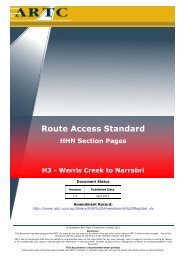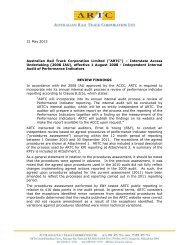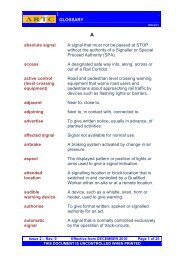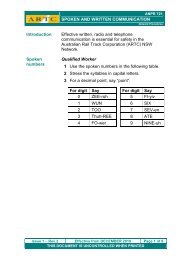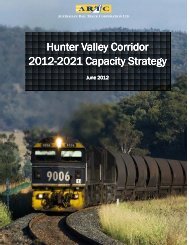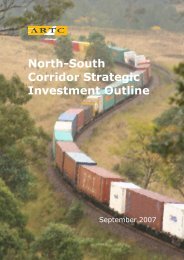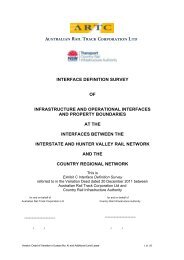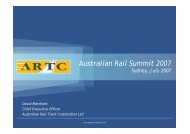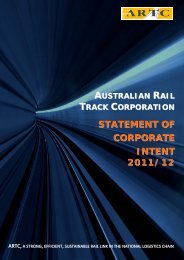MelbourneâBrisbane Inland Rail Alignment Study - Australian Rail ...
MelbourneâBrisbane Inland Rail Alignment Study - Australian Rail ...
MelbourneâBrisbane Inland Rail Alignment Study - Australian Rail ...
You also want an ePaper? Increase the reach of your titles
YUMPU automatically turns print PDFs into web optimized ePapers that Google loves.
The logit model used elasticities obtained from ACIL<br />
Tasman’s surveys of customers, potential customers<br />
and freight forwarders. The model coefficients were<br />
then calibrated to the observed market shares for road<br />
and rail. This enables the interaction between prices<br />
and different aspects of service to be modelled and<br />
estimates of market share to be made for <strong>Inland</strong> <strong>Rail</strong>,<br />
coastal railway and road alternatives. Appendix B<br />
contains details about the logit model and its operation.<br />
Analysis showed that the strongest determinant of<br />
market share is the price of the service, with changes in<br />
price leading to a greater than proportional increase in<br />
demand. There is also demand for reliability of service<br />
with greater sensitivity to reliability than to the speed of<br />
the service. This would imply that it would be beneficial<br />
to use transit time improvements to increase reliability<br />
by increasing the slack in the schedule.<br />
A generally low sensitivity to transit time was identified<br />
through customer interviews and surveys. Despatch<br />
at the end of the day, and arrival early the second day<br />
afterwards (i.e. two nights and a day) was seen as<br />
satisfactory by most respondents. A much faster time,<br />
e.g. 15 hours, would be needed to get significantly<br />
more rail freight, and even then the additional<br />
quantities would not be large. Some anecdotal<br />
evidence from freight forwarders suggested that<br />
some users of rail used the mode as a form of secure<br />
inventory storage, and did not pick up their goods<br />
immediately after the promised delivery time. In one<br />
case, the average pick up was 1.8 days after delivery,<br />
when the maximum permitted storage at the terminal<br />
was 2 days.<br />
<strong>Rail</strong> operators expressed a preference for a faster transit<br />
time to enable faster turnaround of their train assets,<br />
resulting in greater operating efficiencies. This is relevant<br />
to the choice of route which is discussed in Chapter 5.<br />
Faster transit times could result in lower train operating<br />
costs and therefore freight rates, which would affect<br />
demand, though part of the efficiency gain would be<br />
taken as increased profits.<br />
The demand analysis was conducted in consideration of<br />
two scenarios: a base case and a scenario that included<br />
<strong>Inland</strong> <strong>Rail</strong>. The scenario that included <strong>Inland</strong> <strong>Rail</strong> was<br />
incorporated into the demand analysis by using the logit<br />
model of market shares. The model enabled an estimate<br />
to be made of the market share for <strong>Inland</strong> <strong>Rail</strong>, given<br />
the price and level of service being offered by <strong>Inland</strong> <strong>Rail</strong><br />
and its competitors. Parameters to this estimate were<br />
derived from survey results and calibrated to current<br />
market shares.<br />
3.2.1 Price and service attributes assumed<br />
The table below presents the expected price and service<br />
attributes of the intercapital freight market that form the<br />
basis of the demand analysis. These attributes have<br />
been determined in line with the corresponding capital<br />
expenditure forecasts, (Chapter 7), and are included<br />
in the financial and economic analyses (Chapters 10<br />
and 11). It was assumed that it takes, on average,<br />
three years for a change in a service attribute to be fully<br />
reflected in demand. Longer lags of up to 10 years have<br />
been suggested by some stakeholders because of the<br />
required investment in infrastructure and reorganising<br />
logistics chains on the part of customers.<br />
However, the Melbourne–Brisbane traffic is just part<br />
of the total flow that uses customer infrastructure,<br />
and the required adaptation would be incremental.<br />
Not all customers would wait for the development of the<br />
inland railway before instigating significant investments.<br />
They would plan these investments in concert with the<br />
development of an inland railway and would be able<br />
to roll out revised logistics arrangements soon after it<br />
began operation.<br />
Price and service attributes are discussed further below.<br />
The survey indicated that generally, customers are<br />
indifferent to the route, and are more focused on price,<br />
followed by reliability, availability then transit time.<br />
Table 8 Characteristics of Melbourne–Brisbane intercapital market<br />
Relative price*<br />
(vis-à-vis road)<br />
Reliability<br />
Transit time<br />
(door-to-door)<br />
Availability<br />
Road 100% 98% 23.5 hours 98% (declining to 95%)<br />
Coastal railway 57.6% (declining to 53.6%) 77% (after 2015) 32.5 hours (after 2015) 93% (after 2015)<br />
<strong>Inland</strong> railway 52.2% (declining to 48.8%) 87.5% 25.5 hours 95%<br />
Note: *Price varies by commodity. Relativities have been shown here to preserve confidential price information.<br />
This relativity includes pick up and delivery costs for rail freight and is the relative price estimated for non-bulk goods in 2020.<br />
Relative rail price in 2008 is approximately 72% of road, and this declines by 2020 because of increased fuel and labour costs<br />
which affect road more strongly than rail.<br />
The basis of price assumptions is analysis undertaken for ARTC annually. This analysis indicates there are different fronthaul<br />
and backhaul prices, with rail backhaul approx. half fronthaul (55%). for road backhaul prices are approx. 49% of fronthaul.<br />
3. Demand for <strong>Inland</strong> <strong>Rail</strong><br />
ARTC • Melbourne–Brisbane <strong>Inland</strong> <strong>Rail</strong> <strong>Alignment</strong> <strong>Study</strong> – Final Report<br />
11



